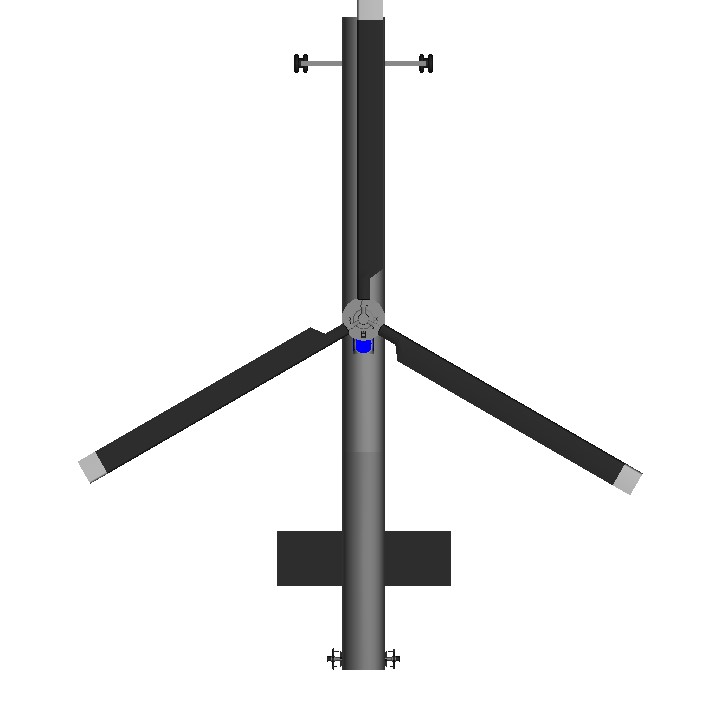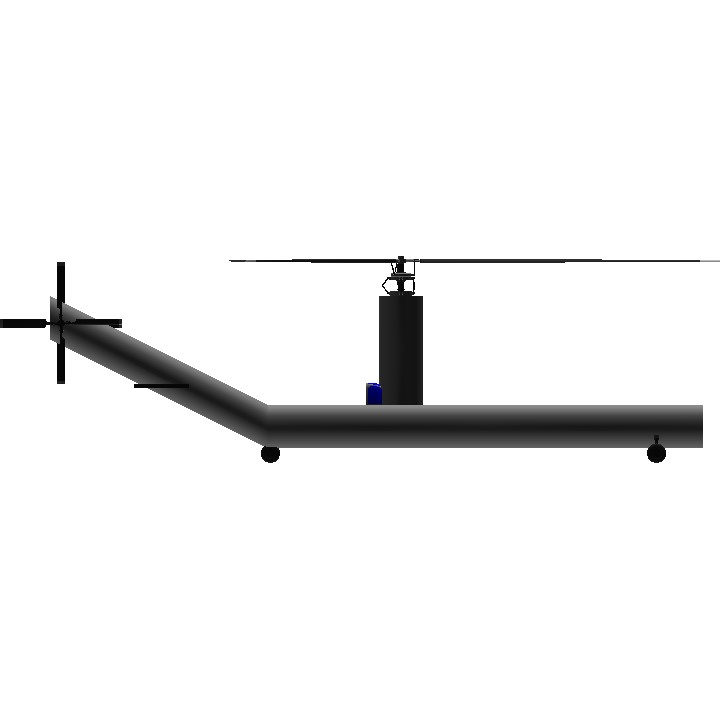Google translate:
T is the T for Test (T for Test)
Although it is used for testing, I still want to increase the stability in flight. In order to eliminate the influence of the ailerons, two ailerons are used. However, the torque of the main rotor still makes the straight flight full of unstable direction changes.
First of all three main parts: main rotor (controlling ascent and descent-pitch), ailerons (controlling horizontal direction-yaw) or suppressing horizontal spin), weight control and a less important additional wing
The relationship between them: the main rotor and weight and additional wings. If their main rotor and weight are not on the same vertical line, they will not be able to control the rotation (ROLL) and control the nose up and down (pitch), and the additional wings can assist Control the ascent and descent (pitch). Usually, the extra wing will be arranged behind the fuselage, so it is usually used to assist the nose up. To assist the nose down, the extra wing can be arranged in front of the fuselage. The extra wing can be seen as an auxiliary nose control for a fixed-wing aircraft, but he cannot control it during flight
The aileron and the main rotor, relative to the importance of the main rotor, the aileron seems to be less important, but it turns out that it is also very important, because the main rotor of the helicopter used for the test is the propeller, the propeller will definitely produce extra during the operation. Directional torque may generate additional force in the direction of the propeller blade in the same direction as the direction of travel. In short, the main rotor of the propeller will generate extra, unnecessary torque. The solution is to arrange the main rotor of the propeller in the direction of ninety degrees. One more propeller or other output to offset this excess torque, and the general arrangement is that the main rotor is responsible for the vertical direction, and the aileron is responsible for the horizontal direction
Conclusion: The general propeller helicopter needs to offset the extra torque brought by the main rotor of the propeller while ascending.
Additional supplement: the two main propellers counter-rotate each other to offset the torque generated by each
If the torque of the main rotor is too large (maybe the speed is too fast but usually the blades of the propeller are too heavy), and the main rotor is too high from the ground, and the width of the fuselage touching the ground is not wide enough, the fuselage will roll over, especially In the take-off phase, this situation cannot be solved with ailerons, at least in my experience
The aileron can be more controllable by changing the control method, generally in the fourth grid from top to bottom, the mode grid, and the right grid is replaced by head hold
The main rotor can be improved by adding vertical and horizontal direction control, cyclic pitch (deg) and cyclic roll (deg), pitch-up and down control, roll-rotation control, and "deg" I can't find out what it means, but pull it It can increase the control of the corresponding direction when it is full, and the main rotor can be slightly adjusted for the weight of the front and back and up and down.
The distance between the weight of the helicopter and the main rotor is almost equal to the relationship between the power output of the fixed-wing aircraft and the weight. If it is too far away and too difficult to control, it cannot be controlled, and if it is too close and too sensitive, it cannot be controlled
Control method:
VTOL-propeller rotation speed
Trim-no
throttle-propeller angle, used upwards
ROLL is ROLL
PITCH is PITCH
Landing advice: the fuselage is very light and it can still gain upward ability at lower speeds of the propeller
The speed can be adjusted to 50% before landing to prevent the fuselage from turning over due to torque after landing, and it can also increase the chances of minor operations.
Note: Although the two ailerons can provide very good horizontal steering, if you rely too much on him to perform a full 180-degree horizontal steering, it will be easy to enter because a certain lift balance makes it impossible to control the aircraft's pitch or even rotation (ROLL) is also uncontrollable. At this time, you can only reduce the engine thrust to slow down, reduce air contact, and then slowly restore controllable performance.
Helicopter control method:
Helicopters and fixed-wing aircraft have different control methods. In my experience, fixed-wing aircraft are easier to control. The control of helicopters is not a single line but front and rear, left and right two lines, and the control method My experience is that first determining the direction angle to the target (south-east, north-west) and then flying close to the target is equivalent to first determining the direction of the straight line to fly, and then flying to the left and right lines and approaching the target on this basis. In terms of control, yaw first, then roll and pitch
have fun
Specifications
General Characteristics
- Created On Android
- Wingspan 42.7ft (13.0m)
- Length 54.3ft (16.5m)
- Height 15.9ft (4.9m)
- Empty Weight 5,722lbs (2,595kg)
- Loaded Weight 9,793lbs (4,442kg)
Performance
- Power/Weight Ratio 18.87
- Wing Loading 242.6lbs/ft2 (1,184.6kg/m2)
- Wing Area 40.4ft2 (3.8m2)
- Drag Points 5550
Parts
- Number of Parts 15
- Control Surfaces 0
- Performance Cost 365




